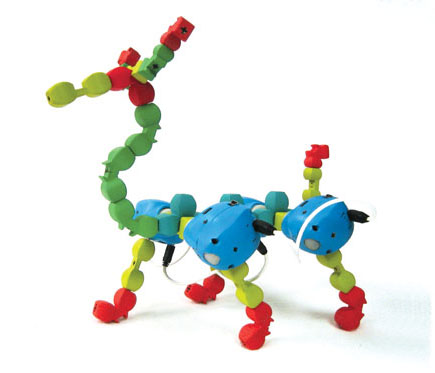Sculpting Behavior - Developing a tangible language for hands-on play and learning
 Hayes Raffle, Nokia Research
Hayes Raffle, Nokia Research
info hayesraffle.com
hayesraffle.com
Seminar on People, Computers,
and Design
Stanford University January 16, 2009
For over a century, educators and constructivist theorists have argued that children learn by actively forming and testing – constructing – theories about how the world works. Recent efforts in the design of "tangible user interfaces" (TUIs) for learning have sought to bring together interaction models like direct manipulation and pedagogical frameworks like constructivism to make new, often complex, ideas salient for young children. Tangible interfaces attempt to eliminate the distance between the computational and physical world by making behavior directly manipulable with one's hands. In the past, systems for children to model behavior have been either intuitive-but-simple, e.g. curlybot or complex-but-abstract, e.g. LEGO Mindstorms. In order to develop a system that supports a user's transition from intuitive-but-simple constructions to constructions that are complex-but-abstract, I draw upon constructivist educational theories, particularly Bruner's theories of how learning progresses through enactive then iconic and then symbolic representations.

I present the Topobo system, a class of tools that helps people transition from simple-but-intuitive exploration to abstract-and-flexible exploration. The system is designed to facilitate mental transitions between different representations of ideas, and between different tools. A modular design approach, with an inherent grammar, helps people make such transitions. With Topobo, children use enactive knowledge, e.g. knowing how to walk, as the intellectual basis to understand a scientific domain, e.g. engineering and robot locomotion. Queens, backpacks, Remix and Robo add various abstractions to the system, and extend the tangible interface. Children use Topobo to transition from hands-on knowledge to theories that can be tested and reformulated, employing a combination of enactive, iconic and symbolic representations of ideas.
![]()
Hayes Raffleis an award-winning product designer and inventor specializing in hybrid physical/digital objects to nurture learning, creative expression, and interpersonal communication. He is currently a researcher at Nokia Research Center, Palo Alto where he is inventing new technologies to connect children with their long-distance families.
Hayes completed his Ph.D. in the Tangible Media Group a the MIT Media Lab in 2008 and received his M.S. from MIT in 2004. His research integrates design, epistemology and human-computer interaction, with a focus on educational toys. Hayes was a LEGO Fellow for six consecutive terms and researched new technologies for hands-on learning. Major projects include the Topobo robotic construction kit, Super Cilia Skin textural communication medium, Jabberstamp drawing tools, and Fuzzmail emotional email application. Hayes's inventions have received numerous international awards and recognition, and have shown in Europe, Asia and North America. His work has received outstanding press from major publications including the New York Times and BBC. Hayes is the author of several patents and over a dozen peer-reviewed academic publications.
Outside of the Media Lab, Hayes has done industrial design for IDEO Palo Alto, and has run the Rafelandia design consultancy in Boston and San Francisco serving diverse clients including SONY and Leapfrog Toys. While completing his B.A. in Fine Arts from Yale University, Hayes helped design and develop the award-winning ZOOB® building toy and later helped to found Primordial, LLC to market, manufacture and sell ZOOB internationally. He is currently bringing Topobo toys to market as principal of Topobo, LLC.
To stay inspired, Hayes enjoys windsurfing, mountain biking, cooking, and spending time with his wife and daughters. Hayes also continues an active art practice creating sculpture and interactive artworks, and he has shown his art in Europe, Asia, and the United States.
![]()
View this talk on line at CS547 on Stanford OnLine or using this video link.
Titles and abstracts for previous years are available by year and by speaker.